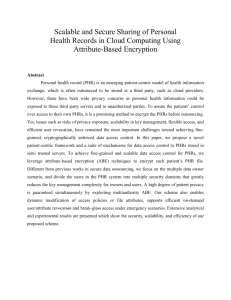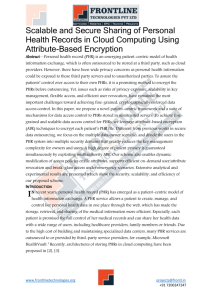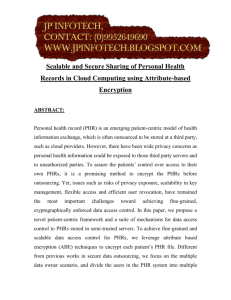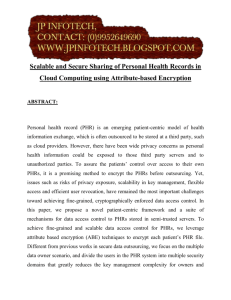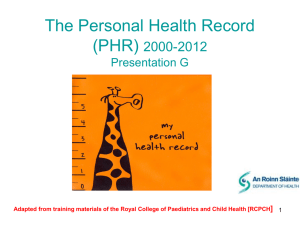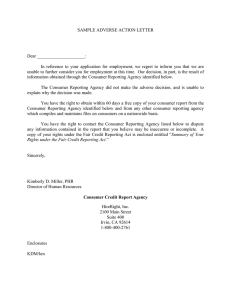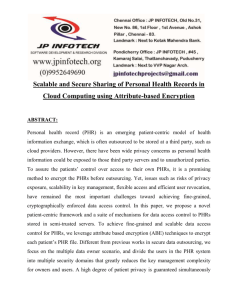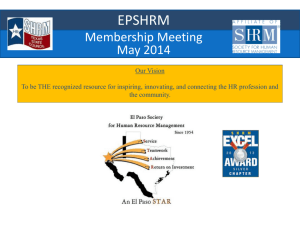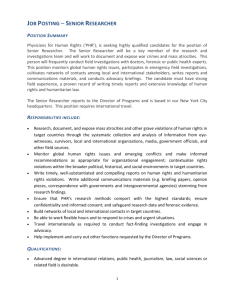International Journal of Application or Innovation in Engineering & Management... Web Site: www.ijaiem.org Email: , Volume 2, Issue 9, September 2013
advertisement
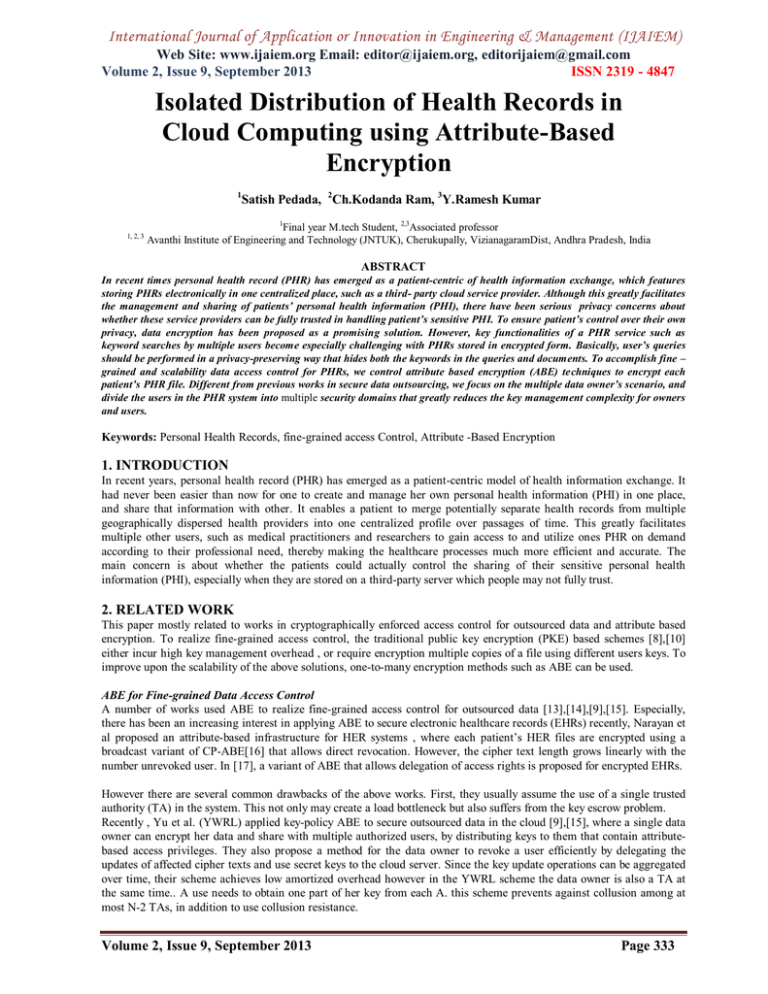
International Journal of Application or Innovation in Engineering & Management (IJAIEM) Web Site: www.ijaiem.org Email: editor@ijaiem.org, editorijaiem@gmail.com Volume 2, Issue 9, September 2013 ISSN 2319 - 4847 Isolated Distribution of Health Records in Cloud Computing using Attribute-Based Encryption 1 1, 2, 3 Satish Pedada, 2Ch.Kodanda Ram, 3Y.Ramesh Kumar 1 Final year M.tech Student, 2,3Associated professor Avanthi Institute of Engineering and Technology (JNTUK), Cherukupally, VizianagaramDist, Andhra Pradesh, India ABSTRACT In recent times personal health record (PHR) has emerged as a patient-centric of health information exchange, which features storing PHRs electronically in one centralized place, such as a third- party cloud service provider. Although this greatly facilitates the management and sharing of patients’ personal health information (PHI), there have been serious privacy concerns about whether these service providers can be fully trusted in handling patient’s sensitive PHI. To ensure patient’s control over their own privacy, data encryption has been proposed as a promising solution. However, key functionalities of a PHR service such as keyword searches by multiple users become especially challenging with PHRs stored in encrypted form. Basically, user’s queries should be performed in a privacy-preserving way that hides both the keywords in the queries and documents. To accomplish fine – grained and scalability data access control for PHRs, we control attribute based encryption (ABE) techniques to encrypt each patient’s PHR file. Different from previous works in secure data outsourcing, we focus on the multiple data owner’s scenario, and divide the users in the PHR system into multiple security domains that greatly reduces the key management complexity for owners and users. Keywords: Personal Health Records, fine-grained access Control, Attribute -Based Encryption 1. INTRODUCTION In recent years, personal health record (PHR) has emerged as a patient-centric model of health information exchange. It had never been easier than now for one to create and manage her own personal health information (PHI) in one place, and share that information with other. It enables a patient to merge potentially separate health records from multiple geographically dispersed health providers into one centralized profile over passages of time. This greatly facilitates multiple other users, such as medical practitioners and researchers to gain access to and utilize ones PHR on demand according to their professional need, thereby making the healthcare processes much more efficient and accurate. The main concern is about whether the patients could actually control the sharing of their sensitive personal health information (PHI), especially when they are stored on a third-party server which people may not fully trust. 2. RELATED WORK This paper mostly related to works in cryptographically enforced access control for outsourced data and attribute based encryption. To realize fine-grained access control, the traditional public key encryption (PKE) based schemes [8],[10] either incur high key management overhead , or require encryption multiple copies of a file using different users keys. To improve upon the scalability of the above solutions, one-to-many encryption methods such as ABE can be used. ABE for Fine-grained Data Access Control A number of works used ABE to realize fine-grained access control for outsourced data [13],[14],[9],[15]. Especially, there has been an increasing interest in applying ABE to secure electronic healthcare records (EHRs) recently, Narayan et al proposed an attribute-based infrastructure for HER systems , where each patient’s HER files are encrypted using a broadcast variant of CP-ABE[16] that allows direct revocation. However, the cipher text length grows linearly with the number unrevoked user. In [17], a variant of ABE that allows delegation of access rights is proposed for encrypted EHRs. However there are several common drawbacks of the above works. First, they usually assume the use of a single trusted authority (TA) in the system. This not only may create a load bottleneck but also suffers from the key escrow problem. Recently , Yu et al. (YWRL) applied key-policy ABE to secure outsourced data in the cloud [9],[15], where a single data owner can encrypt her data and share with multiple authorized users, by distributing keys to them that contain attributebased access privileges. They also propose a method for the data owner to revoke a user efficiently by delegating the updates of affected cipher texts and use secret keys to the cloud server. Since the key update operations can be aggregated over time, their scheme achieves low amortized overhead however in the YWRL scheme the data owner is also a TA at the same time.. A use needs to obtain one part of her key from each A. this scheme prevents against collusion among at most N-2 TAs, in addition to use collusion resistance. Volume 2, Issue 9, September 2013 Page 333 International Journal of Application or Innovation in Engineering & Management (IJAIEM) Web Site: www.ijaiem.org Email: editor@ijaiem.org, editorijaiem@gmail.com Volume 2, Issue 9, September 2013 ISSN 2319 - 4847 3. FRAMEWORK FOR PATIENT-CENTRIC, SECURE AND SCALABILITY PHR SHARING In this we describe our novel patient-centric secure data sharing framework for cloud-based PHR systems. 3.1 Problem Definition We consider a PHR system where there are multiple PHR owners and PHR users. The owners refer to patients who have full control over their own PHR data, i.e they can create, manage and delete it. There is a central server belonging to the PHR service provider that stores all the owners PHRs. The users may come from various aspects for example a User’s access the PHR documents through the server in order to read or write to someone’s PHR, and a user can simultaneously have access to multiple owners’ data. 3.1.1 Security Model In this paper, we consider the server to be semi-trusted, i.e honest but curious as those in and [15]. That means the server will try to find out as much secret information in the stored PHR files as possible, but they will honestly follow the protocol in general. On the other hand, some users will also try to access the files beyond their privileges. For example, a pharmacy may want to obtain the prescriptions of patients for marketing and boosting its profits. To do so, they may collude with other users, or even with the server. In addition, we assume each party in our system is preloaded with a public/private key pair, and entity authentication can be done by traditional challenge-response protocols. 3.1.2 Requirements To achieve “Patient-Centric” PHR sharing, a core requirement is that each patient can control who are authorized to access to her own PHR documentation. Especially use controlled read/write access and revocation are the two core security objects for any electronic health record system. The security and performance requirements and summarized as follows. Data Confidentiality: Unauthorized users who do not possess enough attributes satisfying the access policy or do not have proper key access privileges should be prevented from decrypting a PHR document, even under user collusion. Fine-grained access control should be enforced, meaning different users are authorized to read different sets of documents. On-demand revocation: whenever a user’s attribute is no longer valid, the user should not be able to access future PHR files using that attribute. This is usually called attribute revocation. Write Access Control: we shall prevent the unauthorized contributors to gain write-access to owners PHRs while the legitimate contributors should access the server with accountability. The data access polices should be flexible. Scalalabilty, efficiency and usability: the PHR system should support users from both the personal domain and public doings. Since the set of users from the public domain may be large in size and unpredictable, the system should be highly scalability in terms of complexity in key management, communication, computation and storage.. 3.2 Overview of Our Framework The main goal of our framework is to provide secure patient-centric PHR access and efficient key management at the same time. The key idea is to divide the system into multiple security domains namely public domains (PUDs) and personal domains (PSDs) according to the different user’s data access requirements. The PUD consists of users who make access based on their professional roles, such as doctors, nurses and medical researchers. In practice, a PUD can be mapped to an independent sector in the society, such as the health care, government or insurance sector. For each PSD, its users are personally associated with a data owner and they make access to PHRs based on access rights assigned by the owner. In both types of security domains, we utilize ABE to realize cryptographically enforced, patient-centric PHR access. Especially in a PUD multi-authority ABE is used , in which there are multiple “attribute authorities “ (AAs), each governing a disjoint subset of attributes. Role Attributes are defined for PUDs representing the professional role or obligations of a PUD user. Users in PUDs obtain their attribute-based secret keys from the AAs, without directly interacting with the owners. To control access from PUD users, owners are free to specify role-based fine-grained access polices for her PHR files. types and access requirements in a PHR system. The use of ABE makes the encrypted PHRs self-protective. 3.3 Details of the Propose Framework In our framework there are multiple SDs, multiple owners, multiple AAs, and multiple users. In addition two ABE systems are involved foreach PSD the YWRLs revocable KP-ABE scheme [9] is adopted. For each PUD our proposed Volume 2, Issue 9, September 2013 Page 334 International Journal of Application or Innovation in Engineering & Management (IJAIEM) Web Site: www.ijaiem.org Email: editor@ijaiem.org, editorijaiem@gmail.com Volume 2, Issue 9, September 2013 ISSN 2319 - 4847 revocable MA-ABE scheme is used. The framework is illustrated in fig 1 we term the users having read and write access as data readers and contribute respectively and the below diagram shows the proposed frame work for patient-centric, secure and scalability PHR sharing on semi-trusted storage under multi-owner settings. 4. MAIN DESIGN ISSUES In this section we address several key design issues in secured and scalability sharing of PHR in cloud computing. 4.1 Using MA-ABE in the Public domain For the PUDs, our framework delegates the key management functions to multiple attribute authorities. In order to achieve stronger privacy guarantee for data owners the Chase-Chow (CC) MA-ABE scheme [21] is used. A PHR document with an owner-specified access policy for users from PUD. However, on technical challenging is that CC MAABE is essentially a KP-ABE scheme, where the access policies are enforced in user’s secret keys and those key-policies do not directly translate to document access policies from the owner’s points of view. By our design we show that by agreeing upon the formats of the key-polices and the rules of specifying which attributes are required in the cipher text, the CC MA-ABE can actually support owner-specified document access policies with some degree of flexibility. It functions similar to CP-ABE2 Achieving More Expensive File Access Policies By enhancing key –policy generation rule, we can enable more expressive encryption’s access polices. In the users attributes/roles belonging to different types assigned by the same AA are often correlated with respect to primary attribute type. The basic encryption rule, as long as there are multiple attributes of the same primary type, corresponding non interested attribute tuples are included in the cipher text attribute set. The primary type based attribute association is shown the below fig. There is a “horizontal association” between two attributes belonging to different types assigned to each other. 4.2 Enhancing MA-ABE for User Revocation The original CC MA-ABE scheme does not enable efficient and on-demand user revocation. To achieve this for MA-ABE we combine ideas from YWRL’s revocable KP-ABE[9],[15] and propose an enhanced MA-ABE scheme. In particular , an authority can revoke a user or users attributes immediately by re-encrypting the cipher texts and updating users secret keys while a major part of these operations can be delegated to the server which enhance efficiency. The idea of revoke one attribute of a user in MA-ABE is as follows the AA who governs this attribute actively updates that attribute for all the affected unrevoked users. 4.3 Handle Dynamic Policy Changes Our scheme should support the dynamic add/modify/delete of part of the document access polices or data attributes by the owner. For example, if a patient does not want doctors to view her PHR after she finishes a visit to a hospital, she can simply delete the cipher text components corresponding to attribute “doctor” in her PHR files. Adding and modification of Volume 2, Issue 9, September 2013 Page 335 International Journal of Application or Innovation in Engineering & Management (IJAIEM) Web Site: www.ijaiem.org Email: editor@ijaiem.org, editorijaiem@gmail.com Volume 2, Issue 9, September 2013 ISSN 2319 - 4847 attributes/access policies can be done by proxy re-encryption technique however they are expensive to make the computation more efficient, each owner could store the random number s used in encrypting the FEK3 of each document on her own computer, and construct new cipher text components corresponding to added/changed attributes based on s. the Policy Update algorithm is shown below fig.. Fig shows the MA-ABE scheme with on-demand revocation capabilities. 5. SECURITY ANALYSIS In this section, we analyze the security of the proposed PHR sharing solution First we show it achieves data confidentiality by providing the enhanced MA-ABE scheme to be secure under the attribute based selective-set model.The enhanced MAABE scheme guarantees data confidentiality of the PHR data against unauthorized users and the curious cloud service provider, while maintaining the collusion resistance against users and up to N-2 AAs.We also compare the security of our scheme with several existing works, in terms of confidentiality guarantees control granularity and supported revocation method etc. a privacy preserving EHR system that adopts attribute based broadcast encryption (ABBE) to achieve data access control. 6. COMPUTION COSTS We evaluate the computational cost of our scheme through combined implementation and simulation. We provide the first implementation of the KP-ABE scheme[35] and also integrated the ABE algorithms into a prototype PHR system, IndivoKP-ABE scheme tested on a PC GHz processor, using pairing based cryptography(PBC).And implement the userinterfaces for data input and output. Due to space limitations, the details of prototype implementation are reported in Each PSD user adopts the YWRL scheme for decryption, while each PUD user adopts the enhanced MA-ABE scheme for decryption. Each AA uses MA-ABE for setup, key generation and revocation. And we provide estimations of computation times of each party in the system given below table. The values are calculated from the example parameters and bench mark results, where exponentiation time EXP1 = 6 , 4ms, EXPt = 0.6ms, paring time Tp =2.5ms. Finally we simulate the servers computation cost spent in user revocation to evaluate the system performance of user revocation. Especially, the lazy-revocation method greatly reduces the cost of revocation, because it aggregates multiple cipher text/key update operations, which repays the computations over time. Setup KeyGen(per Enc.(Per file) Dec(Per file) User) Owner Estimates(s ) PSD User Estimate(s) PUD User Estimates(s ) Kth AA Estimate(s) / / / / |L(T)|Exp1 (|AcPSD|+|AcPUD||+1) 0.064 Exp1 + 2ExpT 0.264 / / / / / / / / (|UR|K+1)Exp1+Exp T 0.135 ~|AUk|Exp1 / 0.038 / |Ud|Exp1+ExpT 0.32 Volume 2, Issue 9, September 2013 / / ~|L(T)|Tp 0.025 ~(|AU|m+1)T User Revocation |γ’|Exp1 0.32 p / / / / 0.078 / / |γ’|Exp1 0.032 Page 336 International Journal of Application or Innovation in Engineering & Management (IJAIEM) Web Site: www.ijaiem.org Email: editor@ijaiem.org, editorijaiem@gmail.com Volume 2, Issue 9, September 2013 ISSN 2319 - 4847 7. CONCLUSION We have proposed a novel framework of secure sharing of personal health records in cloud computing. Considering partially trustworthy cloud servers, to fully realize the patient-centric concept patients shall have complete control of their own privacy through encrypting their PHR files to allow fine-grained access. The framework addresses the unique challenges brought by multiple PHR owners and users, in that we greatly reduce the complexity of key management while enhance the privacy guarantees compared with previous works. We utilize ABE to encrypt the PHR data, so that patients can allow access not only personal users, but also various users from public domains with different professional roles, qualifications and affiliations. Furthermore, we enhance an existing MA-ABE scheme to handle efficient and on-demand user revocation, and prove its security through implementation and simulation. We show that our solution is both scalability and efficient. REFERENCES [1] M. Li, S. Yu, K. Ren, and W. Lou, “Securing personal Health Records in cloud computing: patient-centric and fine – grained data access control in mulit-owner settings, in SecureComm’10, Sept 2010, pp. 89-106. [2] H.Lohr, A.R Sadeghi, and M.Winandy , “Securing the e-health cloud” in proceedings of the 1st ACM Interational Health informatics symposium,ser IHI ‘ 10 2010 pp.220-229. [3] M.Li, S. Yu, N. Cao and W. Lou , “Authorized private keyword search over encrypted personal health records in cloud computing” in ICDS ’11, jun , 2011 [4] “ the health insurance probability and accountability act “ [online] available http://www.cms.hhs.gov/HIPAAGenifo/01_overview.asp [5] “Google, Microsoft say hippa stimulus rule doesn’t apply to them” [6] “At risk of exposure – in the push for electronic medical records , concern is growing about how well privacy can be safeguarded” [7] K.D Mandal, P.Szolovits, and I.S kohane , “ Public standards and patients ‘ control how to keep electronic medical records accessible but private” BMJ vol. 322,no.7281 , p 283 Feb 2001 [8] J.Benaloh, M.Chase , E. Horvitz, and K.Lauter , “patient controlled encryption: ensuring privacy of electronic medical records” in CCSW ‘ 09,2009,pp03-114 [9] S. Yu,C.Wang, K.Ren and W. Lou, “Achieving secure, scalability and fine-grained data access control in cloud computing” [10] C.Dong , G. Russello, and N. Dualy , “shared and searchable encrypted data for untrusted servers” in journal of computer security 2010. [11] H. Yang, H. Luo, E.Ye, S. Lu, and L.Zhang, “Security in mobile adhocnetworks : challenges and solutions,” Wireless Communications IEEE, vol 11.no, 1,pp 38-47, feb 2004 [12] N. Attrapadung and H.Imai, “Conjuctive broadcast and attribute-based encryption,” Pairing-Based CryptographyPairing 2009,pp.248-265,2009 [13] S.Muller, S. Katzenbeisser, and C.Eckert, “Distributed attribute based encryption”,information security and cryptography-ICISC 2008, pp,20-36,2009. [14] S.Chow, “New privacy-preserving architecture for identity-attribue-based encryption,” PhdThesis , NYU , 2010. [15] Y.Zheng, “key-policy attribute-based encryption scheme implementation”, http://www.cnsr.ictas.vt.edu/resources.html [16] ”Privacy-Preserving personal Health record system using attribute-based encryption” Master theisis, WORCESTER POLYTECHINIC INSTITUTE,2011 [17] B.Lynn,”Thepbc library,” http://crypto.stanford.edu/pbc/ [18] M.Pirretti, P. Traynor, P.Mcdaniel, and B.Waters, “Secure attribute-based systems”, Journal of computer Security, Vol 18, no 5, pp. 799-837,2010 [19] J.Bethencourt, A. Sahai, and B.Waters , “Ciphertext-policy attribute-based encryption,” in IEEE S& p ’07,2007,pp.321-334. [20] J.A. Akinyele, C. U. Lehman, M.D Green,M. W. Pagano, Z.N.J. Peterson and A.D, Rubin, “self-Protecting electronic medical records using attribute-based encryption”, Cryptology ePrint Archive, Report 2010/565,2010,http://eprint.iacr.org/. [21] M.Chase and S.S.Chow, “Improving privacy and security in multi-authoriy attribute-based encryption” , CCS’ 09,2009,pp 121-130 About Author Mr. Satish Pedada final Year M.tech Student in Avanthi Institute of Engineering Technology (JNTU K) Cherukupally, VizianagaramDist, Andhra Pradesh, India. Volume 2, Issue 9, September 2013 Page 337 International Journal of Application or Innovation in Engineering & Management (IJAIEM) Web Site: www.ijaiem.org Email: editor@ijaiem.org, editorijaiem@gmail.com Volume 2, Issue 9, September 2013 ISSN 2319 - 4847 Mr.Ch.Kodanda Ram working as Associate professor in the department of CSE in Avanthi Institute of Engineering and Technology (JNTUK), Cherukupally, VizianagaramDist, Andhra Pradesh, India. Y. Ramesh Kumar obtained his M.Sc (Computer Science) degree from Andhra University. Later he obtained his M.tech (CST) degree from Andhra University. Presently he is working as Associate Professor and Head of the Department (CSE) at Avanthi Institute of Engineering and Technology, Cherukupally, VizianagaramDist He has guided more than 60 students of Bachelor degree, 40 students of Master Degree in computer Science and Engineering in their major projects. His Research intrest includes Ontology-based information. Extraction Based on Web Search and mining and Ware housing. Volume 2, Issue 9, September 2013 Page 338
